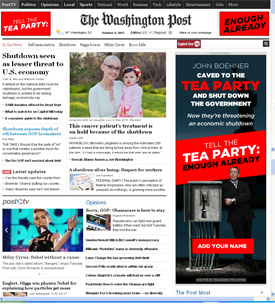If you went to the front page of the WashingtonPost.com on Tuesday, you might have seen something like the screenshot to the right: note the broad expanses of red, a color that just happens to raise human blood pressure when we see it. Those are anti-shutdown “sign our petition” ads run by Organizing For America, the Obama campaign successor organization, and they also feature a leisurely John Boehner leaning against a shut-off switch (get it?). They’re prominent enough to amount to a “homepage takeover” of WashingtonPost.com — they dominate the space “above the fold.”
Or, maybe you saw something completely different — and here’s where it gets interesting. The OFA homepage takeover showed up on both my laptop and iPad, which are admittedly both on the same (geotargetable) cable modem and tied to the same WaPo.com login (I pay for full site access). But various friends in both Texas and NYC DIDN’T see the same pattern of ads when I asked them to check out the site. They saw no OFA ads at all, just the more-typical mix of WaPo advertising, primarily consumer brands.
Based on this tiny sample, I feel comfortable suggesting that these ads are geo-targeted to the Washington DC area or a subsection thereof. It’s possibly they only reach Post subscribers, perhaps ones who fit a particular demographic profile. But that’s about all we can tell without getting a copy of the ad buyer’s insertion order (btw, if anyone would like to leak that, my email is cpd@epolitics.com…). For some cheap thrills, though, let’s try to reverse-engineer this particular ad buy.
First, the ads pitch a petition signup: “Tell the Tea Party ENOUGH ALREADY…Add Your Name.” So, recruiting ads? But if they ARE geo-targeted to the DC area, wouldn’t that be a waste? I.e., just about anybody who lives around here who might want to join the Obama list probably already has, at some point or another. Of course, there are lapsed members who might be coaxed to rejoin, plus tens of thousands of people who’ve moved to the region in the year since Obama was reelected and who might be recruitable. Still, my suspicion is that list-building is secondary: these ads are designed to demonstrate political muscle.
I suspect that these are really aimed at a handful of quite distinct audiences, starting with Republicans on the Hill, to whom it’s a slap in the face and a reminder that OFA has members in their districts. Next, Democrats on the Hill, whom those OFA members can help in 2014 and whose spines might need strengthening in the shutdown fight. And finally, the chattering class, those journalists, bloggers and activists who can be counted on to notice the ads and figure them into their analyses of the messaging war around the shutdown. I wouldn’t even be surprised if this buy weren’t part of a “hey, we’re relevant” campaign designed to boost OFA’s prominence in the political space!
In any case, the paragraphs above are speculation, but they suggest ways that targeted online ads can help a campaign or advocacy group inject themselves and their ideas into the political discussion and perhaps apply a little force in the process. Nothing new, of course — I remember talking with a Post ad salesman eight years ago about using “workplace targeting” to bombard congressional staff, regulators at a given federal agency or even a corporate target with ads, to create the impression of a massive campaign.
More options to demonstrate to Congress that you’re willing to spend money to influence an issue? Big buys on other political sites, of course (Drudge is always a hit on the Right), but don’t forget the physical world, like buying large display ads in the Capitol South and Union Station Metro stations. And I’m still a fan of print ads in the publications congressmembers and staff carry around with them: think about a full-pager in the print version of National Journal Daily (the old Congress Daily). Best of all? Combining channels so that your targets encounter you wherever they look, driving them mad from repetition…good fun all around. Thanks, OFA, for an excuse to think about a subject that never goes out of style.
– cpd

